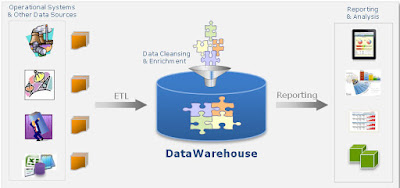
Data
warehousing emphasizes capturing data from various sources for useful analysis
and access, but not generally emanate from the point of view of the end user
who may have access to specialized and sometimes require local databases. This
last idea is known as the data mart.
There are
two ways of data warehousing, top-down and bottom-up. The top-down approach
spins off data marts for specific groups of users after the entire data
warehouse was created. The bottom-up approach to building data marts and then
combines them into a single, comprehensive data warehouse.
Typically, a
data warehouse housed on a mainframe enterprise server or increasingly, in the
cloud. Data from various online transaction processing (OLTP) applications and
other sources is selectively extracted for use by analytical applications and
the user queries.
The data
warehouse term was coined by William H. Inmon, known as the Father of Data
Warehousing. Inmon described a data warehouse as a subject-oriented,
integrated, time-variant and non-volatile collection of data that supports the
decision-making of management.
Online References
E Books
DATA WAREHOUSING: Concepts, Techniques,
Products and Applications
Data Warehouses and OLAP: Concepts, Architectures, and Solutions
Data Warehouses and OLAP: Concepts, Architectures, and Solutions



